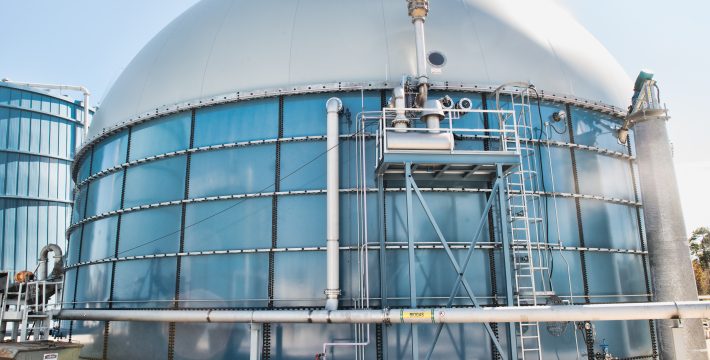What are biogas and biomethane?
Biogas is a mixture of methane, CO2 and small quantities of other gases produced by anaerobic digestion of organic matter in an oxygen-free environment. The precise composition of biogas depends on the type of feedstock and the production pathway; these include the following main technologies:
- Biodigesters: These are airtight systems (e.g. containers or tanks) in which organic material, diluted in water, is broken down by naturally occurring micro‑organisms. Contaminants and moisture are usually removed prior to use of the biogas.
- Landfill gas recovery systems: The decomposition of municipal solid waste (MSW) under anaerobic conditions at landfill sites produces biogas. This can be captured using pipes and extraction wells along with compressors to induce flow to a central collection point.
- Wastewater treatment plants: These plants can be equipped to recover organic matter, solids, and nutrients such as nitrogen and phosphorus from sewage sludge. With further treatment, the sewage sludge can be used as an input to produce biogas in an anaerobic digester.
The methane content of biogas typically ranges from 45% to 75% by volume, with most of the remainder being CO2. This variation means that the energy content of biogas can vary; the lower heating value (LHV) is between 16 megajoules per cubic metre (MJ/m3) and 28 MJ/m3. Biogas can be used directly to produce electricity and heat or as an energy source for cooking.
Biomethane (also known as “renewable natural gas”) is a near-pure source of methane produced either by “upgrading” biogas (a process that removes any CO2 and other contaminants present in the biogas) or through the gasification of solid biomass followed by methanation:
- Upgrading biogas: This accounts for around 90% of total biomethane produced worldwide today. Upgrading technologies make use of the different properties of the various gases contained within biogas to separate them, with water scrubbing and membrane separation accounting for almost 60% of biomethane production globally today (Cedigaz, 2019).
- Thermal gasification of solid biomass followed by methanation: Woody biomass is first broken down at high temperature (between 700-800°C) and high pressure in a low-oxygen environment. Under these conditions, the biomass is converted into a mixture of gases, mainly carbon monoxide, hydrogen and methane (sometimes collectively called syngas). To produce a pure stream of biomethane, this syngas is cleaned to remove any acidic and corrosive components. The methanation process then uses a catalyst to promote a reaction between the hydrogen and carbon monoxide or CO2 to produce methane. Any remaining CO2 or water is removed at the end of this process.
“Biomethane has an LHV of around 36 MJ/m3. It is indistinguishable from natural gas and so can be used without the need for any changes in transmission and distribution infrastructure or end-user equipment, and is fully compatible for use in natural gas vehicles.”



Leave a Comment